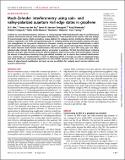Mach-Zehnder interferometry using spin- and valley-polarized quantum Hall edge states in graphene
Author(s)
Wei, Di S.; van der Sar, Toeno; Watanabe, Kenji; Taniguchi, Takashi; Halperin, Bertrand I.; Yacoby, Amir; Sanchez, Javier Daniel; Jarillo-Herrero, Pablo; ... Show more Show less
Downloade1700600.full.pdf (3.563Mb)
PUBLISHER_POLICY
Publisher Policy
Article is made available in accordance with the publisher's policy and may be subject to US copyright law. Please refer to the publisher's site for terms of use.
Terms of use
Metadata
Show full item recordAbstract
Confined to a two-dimensional plane, electrons in a strong magnetic field travel along the edge in one-dimensional quantum Hall channels that are protected against backscattering. These channels can be used as solid-state analogs of monochromatic beams of light, providing a unique platform for studying electron interference. Electron interferometry is regarded as one of the most promising routes for studying fractional and non-Abelian statistics and quantum entanglement via two-particle interference. However, creating an edge-channel interferometer in which electron-electron interactions play an important role requires a clean system and long phase coherence lengths. We realize electronic Mach-Zehnder interferometers with record visibilities of up to 98% using spin- and valley-polarized edge channels that copropagate along a pn junction in graphene. We find that interchannel scattering between same-spin edge channels along the physical graphene edge can be used to form beamsplitters, whereas the absence of interchannel scattering along gate-defined interfaces can be used to form isolated interferometer arms. Surprisingly, our interferometer is robust to dephasing effects at energies an order of magnitude larger than those observed in pioneering experiments on GaAs/AlGaAs quantum wells. Our results shed light on the nature of edge-channel equilibration and open up new possibilities for studying exotic electron statistics and quantum phenomena.
Date issued
2017-08Department
Massachusetts Institute of Technology. Department of PhysicsJournal
Science Advances
Publisher
American Association for the Advancement of Science (AAAS)
Citation
Wei, Di S. et al. “Mach-Zehnder Interferometry Using Spin- and Valley-Polarized Quantum Hall Edge States in Graphene.” Science Advances 3, 8 (August 2017): e1700600 © 2017 The Authors, some rights reserved; exclusive licensee American Association for the Advancement of Science
Version: Final published version
ISSN
2375-2548